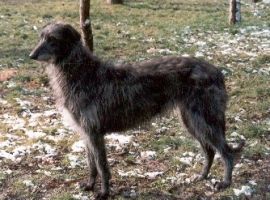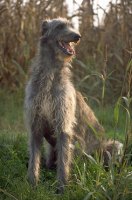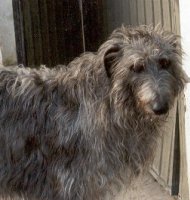DEERHOUND



The splendid subjects of the photos are of Mr. Massimo Sambin of the breeding Septempeda Deerhounds
FCI-Standard N° 164 / 17. 06. 1998 / GB
ORIGIN : Great Britain.
DATE OF PUBLICATION OF THE ORIGINAL VALID STANDARD : 24.06.1987.
SUGGESTED BREEDINGS by MENANDPETS.COM:
No breeding to signal
if you want to know like signaling yours, contacts: marketing@inseparabile.it
UTILIZATION : Racing dog, hunting dog, companion.
CLASSIFICATION F.C.I. : Group 10 Sighthounds.
Section 2 Rough-haired Sighthounds.
Without working trial.
GENERAL APPEARANCE : Resembles a roughcoated greyhound of larger size and bone.
BEHAVIOUR / TEMPERAMENT : The build suggests the unique combination of speed, power and endurance necessary to pull down a stag, but general bearing is one of gentle dignity. Gentle and friendly. Obedient and easy to train because eager to please. Docile and good tempered, never suspicious, aggressive or nervous. Carries himself with quiet dignity.
HEAD : Long.
CRANIAL REGION :
Skull : Flat rather than round, with very slight rise over eyes. Broadest at ears, tapering slightly to eyes. Skull coated with moderately long hair, softer than rest of coat.
Stop : No stop.
FACIAL REGION :
Nose : Slightly aquiline and black.
Muzzle : Tapering more decidedly to nose. In lighter coloured dogs black muzzle preferred.
Lips : Level. Good moustache of rather silky hair and some beard.
Jaws/Teeth : Jaws strong, with a perfect, regular and complete scissor bite, i.e. the upper teeth closely overlapping the lower teeth and set square to jaws.
Eyes : Dark. Generally dark brown or hazel. Light eyes undesirable. Moderately full with a soft look in repose, but keen, far-away look when dog is roused. Rims black.
Ears : Set on high and in repose folded back. In excitement raised above head without losing the fold and in some cases semi-erect. A big thick ear hanging flat to the head or a prick ear most undesirable. Ear soft, glossy and like a mouse’s coat to the touch; the smaller the better, no long coat or fringe. Ears black or dark coloured.
NECK : Very strong with good reach sometimes disguised by mane. Nape of neck very prominent where head is set on, no throatiness.
BODY : Body and general formation that of a greyhound of larger size and bone.
Back : Flat topline undesirable.
Loin : Well arched and drooping to tail.
Croup : Drooping, broad and powerful.
Chest : Deep rather than broad, not too narrow and flat-sided.
TAIL : Long, thick at root, tapering and reaching almost to ground. When standing dropped perfectly straight down or curved. Curved when moving, never lifted above line of back. Well covered with hair; on upper side thick and wiry, on under side longer, and towards end a slight fringe is not objectionable. A curl or ring tail undesirable.
LIMBS
FOREQUARTERS : Forelegs straight, broad and flat.
Shoulders : Well laid, not too far apart. Loaded and straight shoulders undesirable.
Elbow and Forearm : Good breadth desirable.
HINDQUARTERS : With great length from hip to hock. Bone broad and flat.
Hips : Set wide apart.
Stifle : Well bent.
FEET : Compact and well knuckled. Nails strong.
GAIT / MOVEMENT : Easy, active and true, with a long stride.
COAT
HAIR : Shaggy, but not overcoated. Woolly coat unacceptable. The correct coat is thick, close-lying, ragged; harsh or crisp to the touch. Hair on body, neck and quarters harsh and wiry about 7 cm (3 ins) to 10 cm (4 ins) long; that on head, breast and belly much softer. A slight hairy fringe on inside of fore- and hindlegs.
COLOUR : Dark blue-grey, darker and lighter greys or brindles and yellows, sandy-red or red fawns with black points. A white chest, white toes and a slight white tip to stern are permissible but the less white the better, since it is a self-coloured dog. A white blaze on head or white collar unacceptable.
SIZE AND WEIGHT :
Dogs : minimum desirable height at withers 76 cm (30 ins).
Weight about 45.5 kg (100 lbs).
Bitches : minimum desirable height at withers 71 cm (28 ins).
Weight about 36.5 kg (80 lbs).
FAULTS : Any departure from the foregoing points should be considered a fault and the seriousness with which the fault should be regarded should be in exact proportion to its degree and its effect upon the health and welfare of the dog.
Any dog clearly showing physical or behavioural abnormalities shall be disqualified.
N.B. : Male animals should have two apparently normal testicles fully descended into the scrotum.
Automatic translate from inseparabile.com
The origins of the Race:
Between devout the aristocrat of the breeds, the Scottish Deerhound be used from nobilt for the its feat in hunting red deers at least from the sixteenth century. And a po difficult to know its exact history before such date, but probably one race much ancient one, deriving from the ancestral roots of the Greyhound. Cos like for the Greyhound, also the Deerhound could not be possessed from persons who did not possess at least the title nobiliare it of conte, this during ET of the cavalry. Poich the number of the red deers had a decline in England, the majority of the Deerhounds came concentrates to you l where the red deers were remained numerous, cio on Scottish plateaus where they were demands from the heads of the Clans. This palissade of division, provoc the decline of the race to met of 1700, followed from the landslide of the system of the clans of Culloden. An ulterior decline with the advent of the guns in 1800 happened then, poich the Deerhounds was some supplants to you. From the met of 1800, however, a effort was made in order to re-establish the race that dimostr successful, and even if the Deerhounds was not numerous, the qualit of the dogs was high. The first Club of the Deerhound was formed in England in 1860, and around to quellanno, the first Deerhound was exhibited in one canine exposure. The first world war decim still the number of the Deerhounds perch the greater part of the dogs was of propriet of a limited number of large estate owners, the greater part of these did not survive allimpatto of the war. From then, the Deerhound remained low in the high number but in the qualit: a classic in all the senses.
The Temperament:
The Scottish Deerhound allegro, indolent, kind, friendly, graceful and well-mannered gioviale. Pu unottima to be added for the family. To the open, it loves to run and to chase whichever thing that moves. To the inside, it has need of a po of space in order to stretch on one soft surface.
The independent Deerhound but much affectionate one; a extremely sensitive Levriero. an amiable, but often classified dog with the disowned ones. This race goes daccordo with the children, the other dogs and usually also with other domestic animals, even if pu to chase the disowned animals to he.
The Deerhound obedient and easy to manage. And a docile and of good temperament, never suspicious, aggressive or nervous dog. A Levriero of large dignit.
THE STANDARD
Head and skull: enough wide between the orecchie and that it is shrunk progressively towards the snout. These must be appuntito but the labbra ironed. The head must be long, the rather flat skull that round, leggermente found over the eyes, but not in way to approach itself one stop. The skull must be covered of devout hair of moderated length and a po soft of that one of the rest of the cape. The tartufo to leggermente have black (but in some blue subject potr to be also bluastro) and the nasal profile montanino. In the devout subjects to cape clearly, a tartufo black and preferred. Moustaches and beard will have very are supplied of setaceo hair.
Eyes: they must be dark; generally they are dark brown or burnt topaz. Eyes much luminosity are not appreciate. Moderately full Locchio and with sweet expression when the dog and in rest but that it becomes acute and interrogative when eeccitato. The eyelids must be black.
Ears : they must be placed high and in rest it folds to you allindietro like those of the Greyhound; when and excited, the ears come capacities above the skull up but always conserving their fold; in some case are also erected seeds. An ear completely erected and serious defect. An ear large, often, that it hangs plate on cheeks, or covered of long hair (sfrangiato) and considered the most serious defect. Lorecchio to have thin, covered of fine, soft hair to the tact like that one of a rat. Not to have supplied of long hair or frange, but finds a hair short, setaceo and silverplated in the median part and long running the margin. Any is the general bottom of the cape, lorecchio to have black or darkest.
Set of teeth: to scissor. I recorded advanced sormontano to you those inferiors.
NECK: to have along like characteristic of type, the levriero. A neck along not and for excessive desirable poich the job that this dog and called to complete not and that one of a Greyhound; to have also remembered that the criniera and the collar, than every good subject must possess, give limpressione of a less long neck. The nape to have very distinguished from the neck.
LOG: deep thorax but not too much wide. Back leggermente arch. Not and a straight desirable perch beyond that to give little distinguished unapparenza and suitable back not to allow one good sailing point in mountain. Dry, many forts and arch kidneys. Ventre much retratto. In short the devout log and much similar to that one of devout a large Greyhound but of ransom and strongly dossatura.
TAIL: long, attacked low, it comes down nearly until earth, leggermente ricurva and supplied of hard and driven in hair. Sometimes light fringe in tip has one. When the dog and in motion comes raised capacity but dovr never not to exceed the dorsal line. One strongly defective tail that forms a ring or a uncino and.
Front: the shoulders must be very oblique with slanted bachelor and rather drawn near to the apex. Shoulders loaded with straight muscles or are seriously defective. The front limbs will be very straight and in, perpendicularly solid and of good skeleton. Sturdy elbows.
Posterior: wide posterior train devout and the powerful one that are possible. Boneses iliache very distanced. The posterior limbs will be very angled, with good length of the thigh and the leg, which must be wide and flat.
FEET: compact sluices and, with knuckles found and strong nails.
CAPE: the hides, on the log, neck and limbs to have hard and ispido, along 7-10 cm. That one of the head, the chest and the ventre, and much devout soft one. Us sar a light fringe on the posterior part of the limbs is of those front ones that that posterior, but null that is similar the frange of a collie. The Deerhound to have hairy and ispido but not supplied of an excessive hair. A lanoso hair and serious defect. Some subjects have one mixture of serici hairs with lanosi hairs and cio and preferibile to a lanoso cape, but ideal, and driven in, closed, rough, hard the hair and ispido to the tact.
Color: and mainly a taste issue, but not ce some doubt that the blue gray is the preferred one, perch this color is often accompanied to an just webbing, clearly follows the dark gray devout or devout or the tigrato one. The sand, fulvo clearly or the fulvo loaded, especially if with zones nerastre on the orecchie and the snout also they are held in great consideration poich is the colors of the old devout currents of blood, those of the McNeil and the Chesthill Menzies. The white man and considered serious defect, but chest white man and feet white men, poich is cos frequent between the dogs to the darkest mantle, comes tolerates to you. In spite of us, except extended they are these macchiature much best sar, poich the ideal and unicolore Deerhound. A spot white woman on the head or a collar white man must be penalizes to you. However, even if sure small spots white women are tolerable, must be made every effort in order to try to eliminate them. In other words, minor white man we have better and sar, even if one lightest spot on the tip of the tail and present also in the best subjects. Weight and height: males from 43 kg to 51 kg, females from 35 kg to 40 kg. Laltezza of the males would not have to be inferior to 76 cm and that one of the females to i 71 cm.
Defects: covered thick orecchie that fall back flat to sides of the head or abundantly of long hair. Goffered tail or that form a ring. Clear eyes, straight dorsal line, posterior limbs you vaccinate, metacarpi weak people, posterior little angled, feet increases to you or opened, lanoso cape, shoulders straight and loaded with muscles. Spots white women.
THE TOELETTATURA
The Deerhound has a hard hair, ispido to the tact, of length between 7 and i 10 cm. It must have a good ones sottopelo that the protegga from the cold of the winter months. Council to wash the every dog approximately two months and risciacquar it a lot much good, in order to avoid that it can grattar subsequently, because of eventual a residual one of shampoo. During the particularly cold months, it would be better not to wash it at all. Brushed important E' instead a good one and, endured after, combing with a steel comb to tips rounded off, this in order to remove the excess of sottopelo that it could render it, in its with, a dog from the lanoso hair. The brush and the comb would be from using at least a pair of times the week.
The pulizia of the orecchie it would have it are made approximately every ten days, in commerce are optimal products for the pulizia auricular, e' important not to use cotton rods, perche' with an unexpected movement of head of the dog, could ledergli the eardrum.
The cut of nails e' a famous one hurting for the Deerhound, poiche' little loves this practical one; if you are little expert in the thing, e' better to turn you to the confidence veterinary and to ask he. The Deerhound not e' a dog from streeping absolutely, no part of its body goes modified using small knife from streeping or scissors, tantomento in sommit of the long skull or the neck. Viceversa a head supplied of hair to its sommit and folto a collar, are much characteristic in the race. Exception vien made as far as the orecchie that, only this last, they go strippate delicately only using the inch and the index. For the removal of the Tartar from the teeth, you offer to your dog a bone of bufalo or the bone of the prosciutto, rosicchiando same, sara' piu' that the sufficient one in order to remove the Tartar. If cio' it did not have to be enough, then fortified of one small currency to you and with the same one grattate on the tooth, being you attend not to hurt the gum. Concluding: The Deerhound e' a dog from the aspect extremely peasant, lacking in every leziosita' that it would make it to appear piu' a dog from drawing-room that a dog from deer hunting. Avoided therefore to wash it too much often, this would stimulate the sebacee glands to produce piu' sebo. If you want dargli one cleaned up without to bathe it, spargetegli over of the borotalco and then massaggiate with the aid of a towel. Fact cio' spazzolatelo.
Bibliography: Deerhound - author: Kay Barret - in English language
The Deerhound - author: A.N. Hartley - in English language
Scottish Deerhounds - author: Audrey Benbow - in English
Popular Sight Hounds - author: Juliette Cunliffe in English
The levrieri - authors: Ernesto and Giovanna Goat in Italian
The Levrieri - author: Piero Renai of the Rena in Italian
we thank Mr. Massimo Sambin of the breeding Septempeda Deerhounds
for the kindly supplied material and the precious collaboration